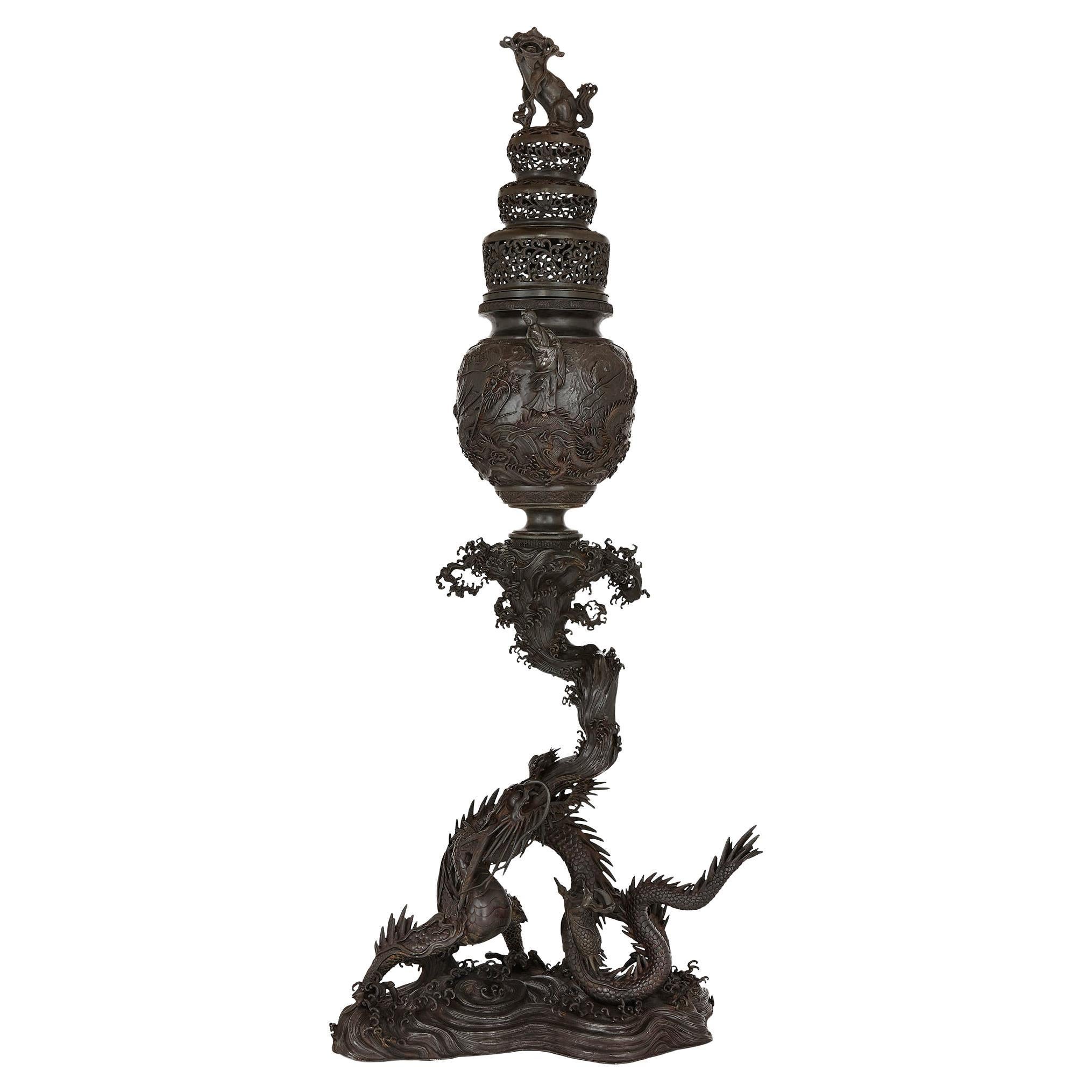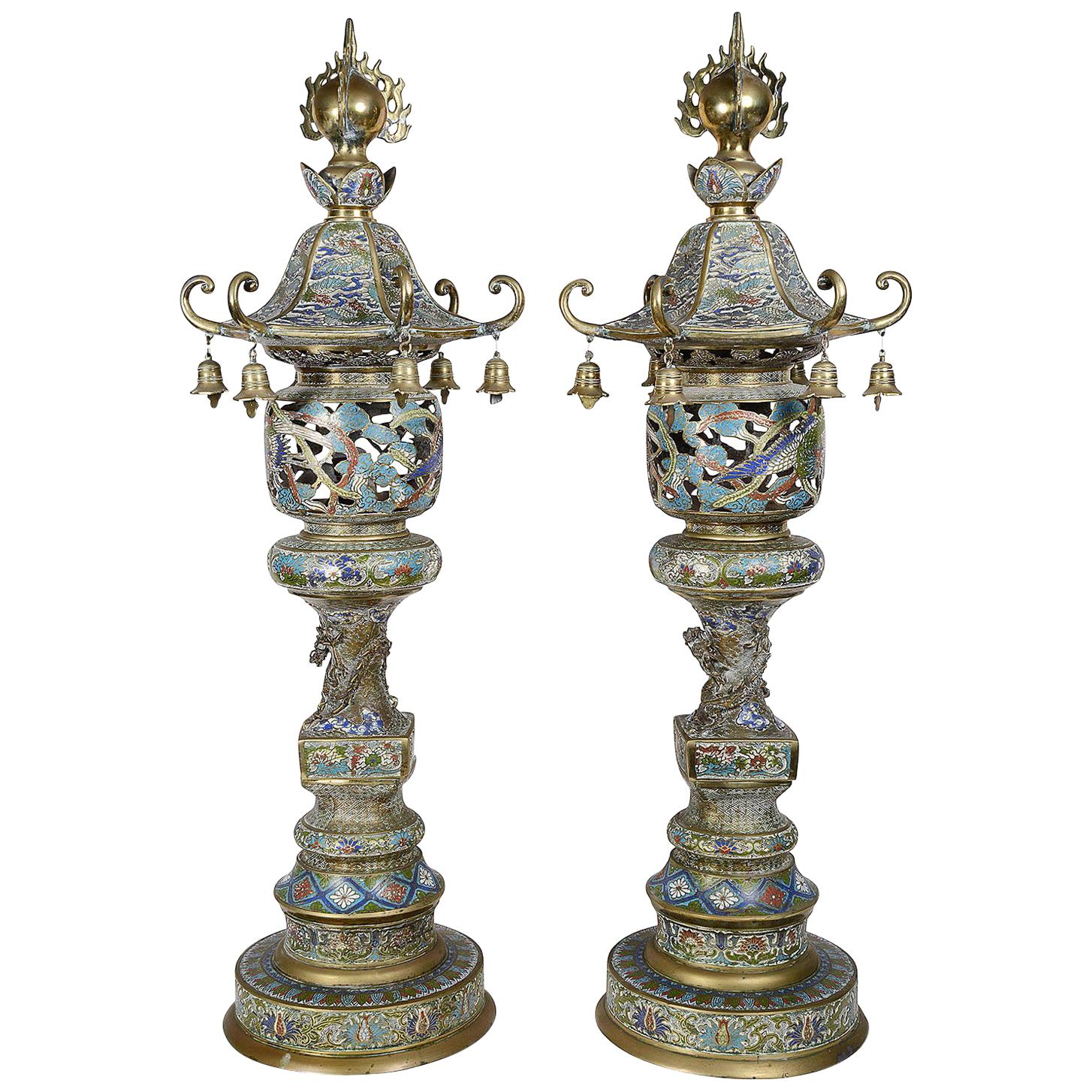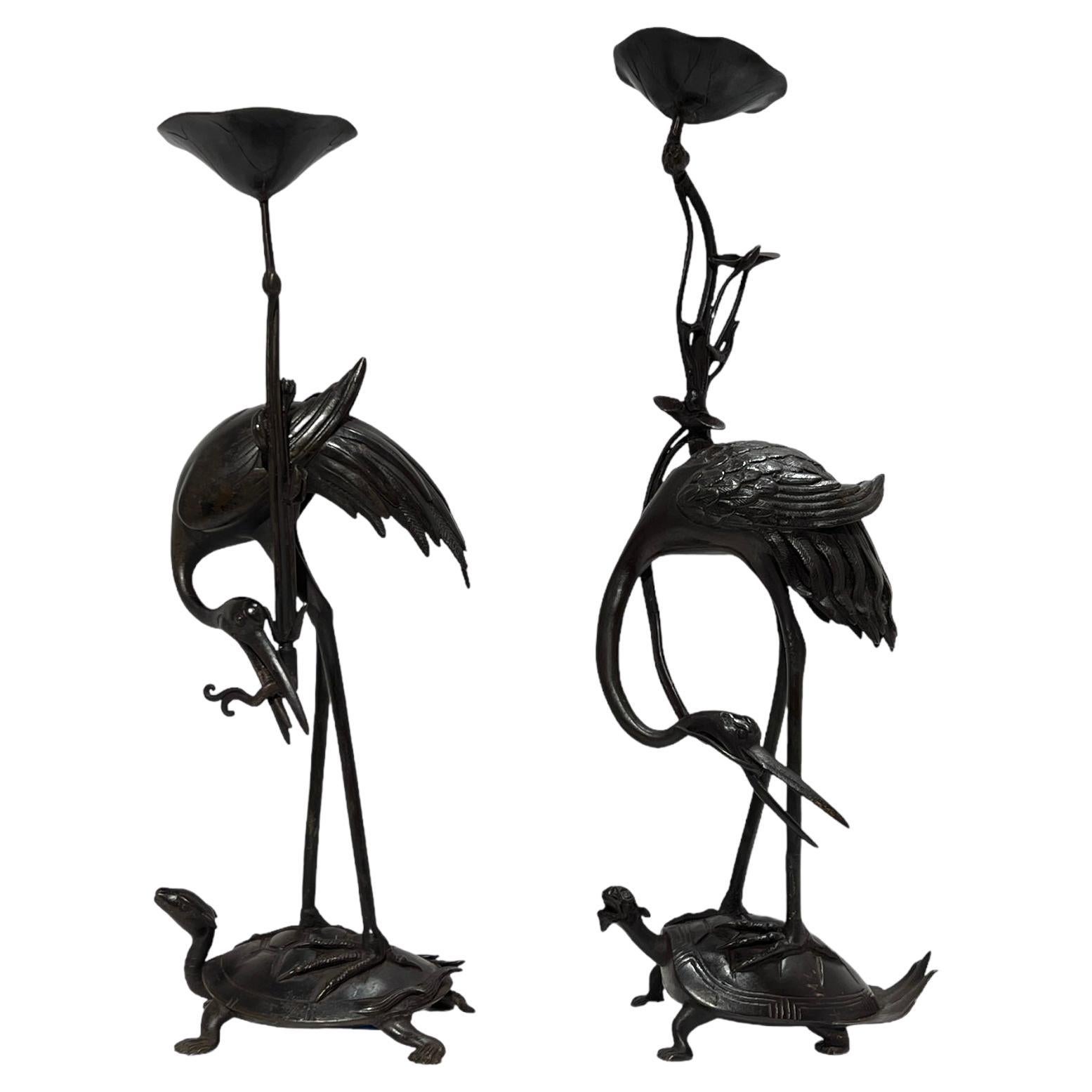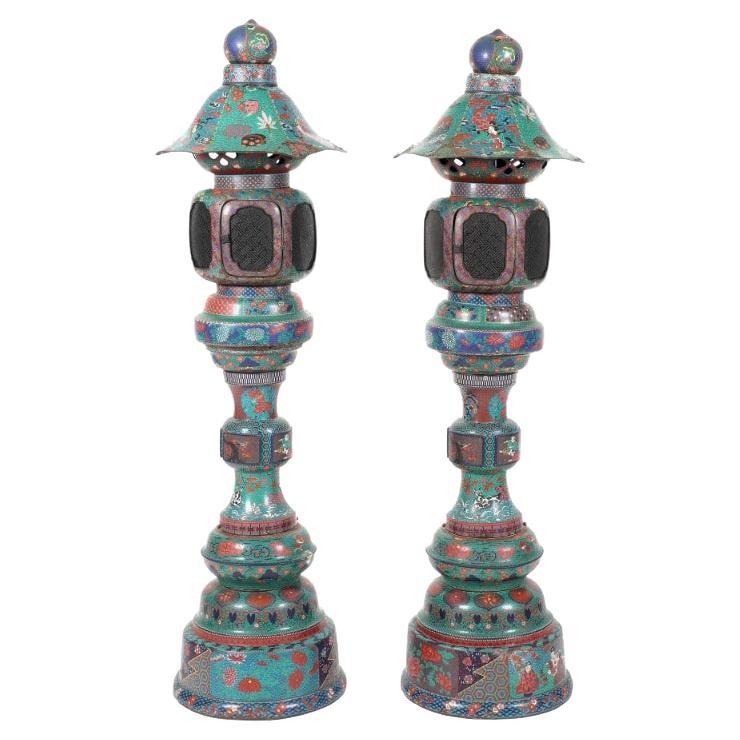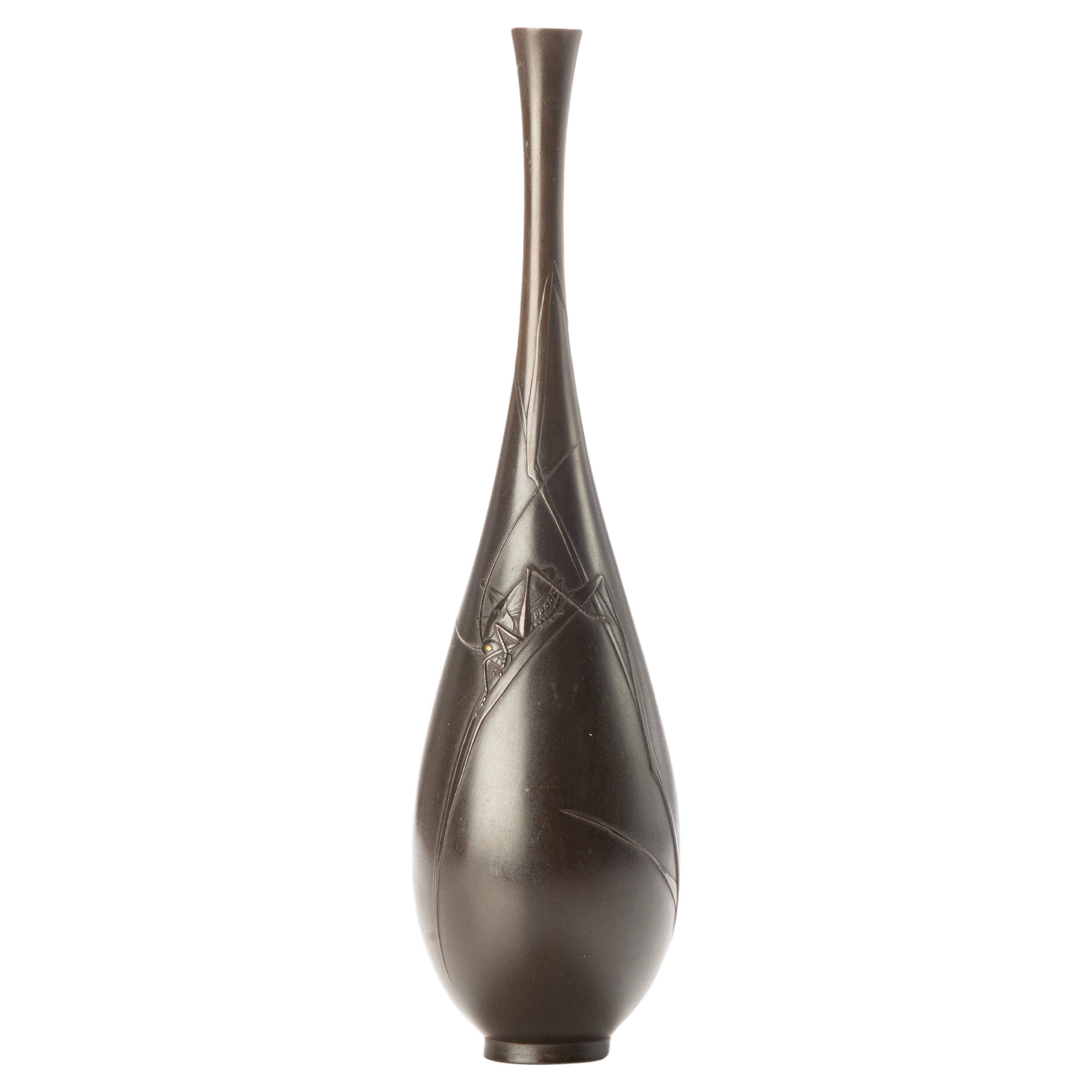Items Similar to Pair of large dark brown patinated bronze Japanese lanterns 灯籠 (tôrô)
Want more images or videos?
Request additional images or videos from the seller
1 of 11
Pair of large dark brown patinated bronze Japanese lanterns 灯籠 (tôrô)
About the Item
A pair of amazing, large dark brown patinated bronze Japanese electrified lanterns (tôrô). The pagoda-shaped top crowned by a hôju (sacred jewel) and fitted with ‘warabite’-shaped points hung with bells. The body with an openwork scrolling vine (karakusa) design adorned by a shiny copper circular applique featuring a flower crest.
The upper rim of the hourglass-shaped base decorated with scrolling vines as well.
Both lower rims with dated inscriptions. Dated ‘The 3rd of October of Shôwa 46’, Anno 1971.
Weight: 20.28 lbs / 9.2 kg. Each.
When shipped we will add a certificate of authenticity.
Price including insured shipping.
- Dimensions:Height: 36.03 in (91.5 cm)Diameter: 16.15 in (41 cm)
- Sold As:Set of 2
- Materials and Techniques:
- Place of Origin:
- Period:
- Date of Manufacture:Shôwa 46, Anno 1971
- Condition:Repaired: Both with original electrification and fitting, but with new EU-plugs. Replacements made: One bell of different shape. Wear consistent with age and use. In a very good condition with minimal traces of wear conform age. Different parts can be removed from each other. No lamp bulbs included. Please look at the photos for a condition reference.
- Seller Location:Amsterdam, NL
- Reference Number:
About the Seller
5.0
Vetted Seller
These experienced sellers undergo a comprehensive evaluation by our team of in-house experts.
Established in 1996
1stDibs seller since 2022
16 sales on 1stDibs
Typical response time: 10 hours
- ShippingRetrieving quote...Ships From: Zwanenburg, Netherlands
- Return PolicyA return for this item may be initiated within 14 days of delivery.
More From This SellerView All
- Japanese Red Patinated Bronze Vase by Nakajima Yasumi II 二代中島保美By Nakajima Yasumi IILocated in Amsterdam, NLExceptionally shaped bronze vase with a striking ‘coarse’-textured red mottled patina. The bowl subtly shaped like a flower, its slightly concave body flanked by ‘butterfly wing’-sha...Category
20th Century Japanese Metalwork
MaterialsBronze
- Very large Japanese bronze 4-tiered trumpet vase with intricate wave designLocated in Amsterdam, NLRemarkable and very large bronze 4-tiered trumpet vase intricately designed with a motif of tumultuous waves. It’s crafted to give the impression that the trumpet-shaped chalice, is ...Category
Antique Late 19th Century Japanese Metalwork
MaterialsBronze
- Heavy, Japanese bronze temple bell 梵鐘 (bonshô) of traditional shapeLocated in Amsterdam, NLHeavy bronze temple bell (bonshô) of traditional shape with an appealing echoing sound when struck. Its surface is a rich brown, complemented by a hint of light green aged patina. ...Category
Mid-20th Century Japanese Metalwork
MaterialsBronze
- Japanese Bronze Okimono of a 'Karasu Tengu' 鴉天狗 Holding Up a Flower BranchLocated in Amsterdam, NLVery refined Japanese bronze okimono of a ‘karasu tengu’ holding a candlestick. Well cast as a tengu in half-human, half-bird form standing atop a pile of leaves on a rounded square...Category
Antique Late 19th Century Japanese Metalwork
MaterialsBronze
- Pair of Japanese High Quality Chôshi 銚子 'Sake Ewers', Signed 'Sei’ô' 晴王Located in Amsterdam, NLPair of high quality cast iron chôshi (sake ewers) with a detailed lacquered lid. Its body with a refined embossed design of a bird of prey (môchô) perched o...Category
Antique Late 19th Century Japanese Antiquities
MaterialsIron
- Impressive Japanese bronze mimikuchi 耳口 (ear-mouth) flying handle vase.Located in Amsterdam, NLFantastically shaped large Japanese bronze mimikuchi (ear-mouth) flying handle vase. The vase has two large flat handles smoothly running into the mouth, its body has four sides and each side is decorated with a spiral in relief. With very nice original patina. Mimikuchi-form vases derive from archaic Chinese pottery...Category
20th Century Japanese Metalwork
MaterialsBronze
You May Also Like
- Large Patinated Bronze Japanese Koro Incense BurnerLocated in London, GBLarge patinated bronze Japanese koro incense burner Japanese, late 19th Century Dimensions: Height 221cm, width 97cm, depth 57cm This monumental koro...Category
Antique Late 19th Century Japanese Meiji Metalwork
MaterialsBronze
- Pair of Bronze and Enamel Japanese Garden Lanterns, circa 1900Located in Brighton, SussexA good quality pair of Japanese bronze and enamel pagoda shaped garden lanterns. Each with a patinated bright bronze finish and multicolored classical enamel decoration, circa 1900.Category
Early 20th Century Japanese Japonisme Metalwork
MaterialsBronze, Enamel
- Pair Antique bronze Patinated Japanese Crane Form CandlesticksLocated in New York, NYPair of 19th century Meiji period Japanese candle holders in patinated bronze, fashioned as cranes (or herons) standing on minogame turtles.Category
Antique 1890s Japanese Meiji Metalwork
MaterialsBronze
- Pair Japanese Bronze Pagoda Temple Lanterns, Taisho Period, circa 1920, JapanLocated in Austin, TXAn elegant pair of Japanese cast and lacquered bronze pagoda lanterns, Taisho Period, circa 1920, Japan. The lanterns a true pair, with mirrored decorations and lantern doors opening in opposite directions. The lanterns of traditional toro form, cast in bronze, and lacquered. Each lantern comprised of three parts - the "roof", the "fire box", and the pedestal. This type of pedestal lantern is called a dai-doro, as opposed to the hanging lantern type, tsuri-doro. The hexagonal roof of the lantern, reminiscent of temples or pagodas, features a wonderful, dense cloud pattern with three heart-shaped cutouts, known as inome, or boar's eye. The roof topped by a hoju, the Buddhist flaming Jewel of Wisdom. Each of the six corners feature a fantastic shachihoko, mythical beasts with the face of a tiger and body of a fish. Bells are suspended from the shachihoko. The globular body of the lantern features four pierced panels with the three leaf hollyhock mon of the Tokugawa clan surrounded by a karakusa pattern of scrolling vines. One panel serving as a hinged door with a lock stylized as the Three Jewels...Category
Vintage 1920s Japanese Taisho Lanterns
MaterialsBronze
- A Japanese patinated bronze vase depicting a cricketLocated in Milano, ITA slender shape patinated bronze vase depicting a naturalistic scene of a cricket sitting on iris leaves. Signed Joun in relief within an oval reserve. Origin: Japan Period: Meiji ...Category
Antique Late 19th Century Japanese Japonisme Metalwork
MaterialsBronze
- Large Pair of Japanese Cloisonne Enamel Lanterns Attributed to Kaji TsunekichiLocated in New York, NYA Large Pair of Japanese Cloisonne Enamel Lanterns Attributed to Kaji Tsunekichi, Edo Period, 19th century Japanese cloisonne lanterns were made during the Meiji period, from the late 19th to early 20th century, and were often used as decorative lighting fixtures in temples and shrines. Kaji Tsunekichi (1866-1916) was a Japanese cloisonné artist who was active in the late 19th and early 20th centuries. He was born in Tokyo and learned the art of cloisonné from his father, Kaji Sataro, who was also a cloisonné artist. He was renowned for his mastery of the shippo-yaki technique, which involves creating intricate designs with thin wires on a metal base before filling in the spaces with enamel. Tsunekichi was known for his exceptional technical skills and his ability to create intricate designs with vibrant colors. His works often featured nature motifs, such as flowers, birds, and fish, which were rendered in a highly detailed and naturalistic style. He also experimented with new techniques, such as plique-à-jour, a type of cloisonné that creates a stained-glass effect. Tsunekichi's works were highly prized during his lifetime and continue to be sought after by collectors today. He won numerous awards for his cloisonné creations, including a Gold Medal at the 1900 Exposition Universelle in Paris. His works are characterized by their fine wirework, precise enamel application, and attention to detail. Some of Tsunekichi's most famous works include a pair of large cloisonné vases...Category
Antique 19th Century Japanese Edo Metalwork
MaterialsCopper, Enamel
Recently Viewed
View AllMore Ways To Browse
Iron Kama
Asian Ceremonial Dagger
Japanese Cloisonne Incense Burner
Large Outdoor Incense Burner
Etched Indian Pot
Meiji Period Japanese Bronze Bird
Tibet Dagger
Two Large Khmer Foo Dogs
Meiji Era Bronze
Naga Sword
Silver Torcs
Antique Asian Bronze Chariot With Dragon Head
Antique Indian Spice Tin
Antique Kick Scooters
Asian Trumpet Shape Brass Vase
Bronze Koi Vase
Cloisonne Bowl And Tray
Rosenthal, Jacob & Co (J. Rosenthal & S. Jacob) On Sale
